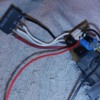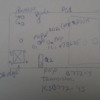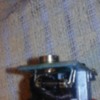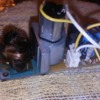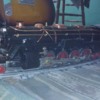Repair made..smoke for Christmas..replaced bridge and capacitor.. 4Amp bridge. 470uf cap..they didn't have 330uf. Radio shack did not. Have I C....that bridge is not going to fry..
Now, that's a BRIDGE RECTIFIER! ![]()
lost power again, so need to rebuild the whole thing,
Q2, can you use a 7805 reg, or is it different, Q1, IC1, ,,,in another post I see IC1 is 78L05 , what is Q1,? transistor? R1, R1, D2, I would think radio shack would have it,, do any of these have cross ref ,,numbers,,
thanks
Q2 is a bi-polar transistor: http://www.mouser.com/Search/R....aspx?Keyword=B772-Y
Q1 is also a bi-polar transistor, I'd probably drop in a 2N2222A if you can't find the exact replacement. I can't read the number on my PS/1 smoke unit.
R1 & R3 are the smoke resistors, they're 3W wirewound resistors that are in the smoke chamber.
R1 is a 1.8K-ohm 1/4W composition resistor, R2 is a 470 ohm 2 watt wire wound resistor. I'd use a 1W 13V Zener at D2.
I seriously doubt that Radio Shack has R1, D2, or Q2.
Why do you "need to rebuild the whole thing"? Unless the physically destroyed the board it's hard to believe you need to replace some of these parts.
You cannot use a 7805 regulator IC for Q2. Q1 is transistor. From what I can tell Radio Shack does NOT carry D2 which is a so-called "zener diode" with a value of 13V (probably 1/2 Watt).
gunrunnerjohn posted:Q1 is also a bi-polar transistor, I'd probably drop in a 2N2222A if you can't find the exact replacement. I can't read the number on my PS/1 smoke unit.
Per schematic Q1 is a PNP transistor (2N2222A is NPN). I can read the Q1 marking on my PS1 board as "A1266" - so search for "A1266 PNP transistor" which appears to have a NTE cross-reference.
OOPS, I looked to quickly Stan, thanks for picking that up! The Q1 reference I used was the one on my board exactly.
trying to figure out what gave up, its easier to rebuild it,,,plan to get the PNPs, and diode,
we have a place called frys electronics, they carry a lot of parts, they own radio shack,, I think the other places we have are closed today,
the pnp are the ones I think gave up,,the wire wound resistor has some discolor on it,
thanks,,,,
| BR1; DF04 1A Bridge Rectifier |
| R1; 1.8K ohm, 1/4 W resistor |
| R2; 470 ohm 1 W resistor |
| C1; 330uF, 35V electrolytic cap |
| IC1; LM78L05 regulator |
| Q1; 2SA1266 PNP transistor |
| Q2; 2SB772 PNP transistor |
| D1; IN4743 13V zener diode |
Test for output voltage of rectifier. Test for 5V at smoke fan motor, check for burned traces. Check heating elements for open, test for shorted transistors. G
Nice list George, where did you come up with all the actual parts?
on my board D2 is diode,, D1 is next to bridge
I was able to find parts at frys,, but no go, think board is shorted, where bridge is, that area was cooked, did order parts too, 6 bucks for mailing,
any boards out there, no juice anywhere,, did jumper across smoke resistor, nothing,
If the board "cooked" near where the bridge rectifier goes (but the actual bridge rectifier component is located off-board as in your photo) , then there probably is a short in that area. Even if one or both transistors failed (whether shorted or open) the circuit will generate heat thru one or both smoke resistors. If you got no heat at all from the smoke resistors and the fan did not spin, this could indeed be explained by a board short near the bridge rectifier.
What kind of multi-meter (if any) do you have?
The printed-wiring on the board is "simple" enough that you ought to be able to see a short by visual inspection. Can you post a close-up photo of the printed-wiring on your cooked board?
Photo added; note the red arrow, a solder splash at the tip of the arrow for example would short the output of the bridge rectifier even if your bridge rectifier is off the board.
Attachments
gunrunnerjohn posted:Nice list George, where did you come up with all the actual parts?
Directly from the MTH spread sheet of common parts. Though I also have my own list of component parts for boards. G
I must have missed it, I checked the common parts spreadsheet...
I did miss it, but they say 4.3V Zener diode! ![]() I see the part actually is the 13V part number. I need to look more carefully next time!
I see the part actually is the 13V part number. I need to look more carefully next time!
I let service know of that misprint years ago....![]() I corrected it in my file. G
I corrected it in my file. G
I think it better to try to troubleshoot the board vs. replacing every part and crossing your fingers. That is, the circuit is relatively simple and we have the unusual benefit of the schematic and parts list. But that's just my opinion - and it's true that guiding someone thru a measurement maze can get tedious.
That's a PS2/PS3 MTH smoke unit. It only has the heater resistors and the DC fan motor. The regulator electronics is on the PS2/PS3 circuit boards which processes the track voltage for both conventional and command operation. A DIY regulator circuit to drive this for conventional track voltages (as I believe you're using) would be similar in complexity to what you have on the PS1 board. That is you still need a bridge rectifier, capacitor, a 5V regulator IC (78L05) for the DC fan motor, and some kind of regulator circuitry to drive the heater resistors.
thanks,,stan,, modify not a problem,
q,
is there a spec sheet on the PS2?,, the motor I should be able to use a standard 5 volt regulator , circuit, bridge, cap,,7805 regulator, ,, just don't know the volts resistors max at.
Like your motor, the smoke resistors don't have a voltage max per se. You just need to limit the power they dissipate.
That PS2 smoke unit has two 16 ohm resistors in parallel making it an 8 ohm load. Apply your 20V to that and you'll get a whopping 20V x 20V / 8 ohms = 50 Watts which would interesting and probably spectacular...for a few seconds that is. With an 8 ohm heater load you need to drop the voltage to something like 6V (or so) which would be 6V * 6V / 8 ohms = 4.5 Watts.
The problem with lowering 20V to 6V using a resistor or a typical regulator IC (like a 7806) is that 14V drop goes up as wasted heat. If you have the space, I'd look at one of those 99 cent eBay regulator modules. It takes unregulated DC input and generates regulated DC out and is adjustable so you can set it to 6V, 6.5V, 7V, whatever. You'll already have DC input voltage from your bridge rectifier.
Attachments
stan, I gotta, plan, I can use that ps1 board that needs a smoke unit on it!, ,, I will look for 5v boards, run hook up both motor and resistors to it see what I get,,,,,,then again,,it would be cool to see sparks fly!,,
The reason for the odd arrangement on the PS/1 smoke unit is what Stan is alluding to. While they are using the same 16 ohm resistors, the PS/2 smoke just wires them in parallel and drives them with a PWM signal from the PS/2 electronics.
The PS/1 board, OTOH, runs one of the 16 ohm resistors and shorts the other one until the rectified input DC voltage reaches about 13 volts, then turns Q2 off and places the two resistors in series so that you have a resistance of 32 ohms for the higher input voltages.
I've seen the PS/2 smoke unit when the smoke FET shorts on the PS/2 board, things get pretty exciting for a short time before it dies. ![]()
here is what I get, transformer with bridge, + to red lead, - to yellow wire of motor, motor runs, no smoke.
with power disconnected measure resistance using meter of each heater resistor. should measure about 16 ohms each.
change the voltage from transformer a few volts and make sure the motor stays constant speed. this will confirm a lot is working right.
as noted earlier, even if one or both of the transistors Q1 and Q2 failed you will generate some heat in the heater resistors. If you get no warming at all in either of the heater resistors, then a) one of your heater resistors failed "open" (and you won't measure any resistance) or b) there is a break in the printed- wiring connection from the output of the bridge rectifier to the resistors.
needle swings all the way , like checking for ground,
riki posted:Here they are...it got hot!
So you're getting heat and the fan is spinning. Kind of begs the question, "so what's the problem?"
If you want to see if you're getting the right amount of heater power, measure the DC voltage across each resistor with an incoming voltage of, say, 16V AC.
If you measure across the resistors with a low voltage, say 7-8 volts AC, one of the resistors should have very little DC voltage across it. When you jack the power up to 16 volts AC, both should be powered. If that's the case, your job is done. ![]()
ok I applied power across front resistor, that started burning up transistor B772-Y,,Q2,,,applied power across inner resistor got heat. nothing cooking.....no motor,
Whoa! Are you applying power or voltage directly to the heater resistors? If so, I implore you to cease and desist!
As GRJ suggests above, if you want to see if the circuit is operating as intended you can ramp up the AC voltage input while measuring the DC voltage across each resistor. At low AC input voltage there will be little if any DC voltage across the resistor attached to the 772 transistor; this is because the 772 is "ON" effectively shorting the resistor. At high AC input voltage the 772 transistor turns "OFF" allowing DC voltage across the resistor. When this happens both heater resistors are active with each dropping 1/2 of the available DC voltage from the bridge rectifier.
Well..i know resistor s work...i guess i could by the board. And do like the ps2..
Gosh, I hope nothing in my replies suggested you apply voltage directly to the resistors! There's only one place in the circuit you should be applying power, that would be the input power pins!
Not a big deal..cause it all can be rebuilt.
Their was no power at input.capacitor had juice..
My point is, putting power at random points in the circuit will most likely toast more components.
Sounds like you're having a grand time messing with this stuff. That's a good thing! Nothing like learning from the school of hard knocks, burnt fingers, etc.. hopefully no exploding capacitors in your face though.
So is there a question on the table?




